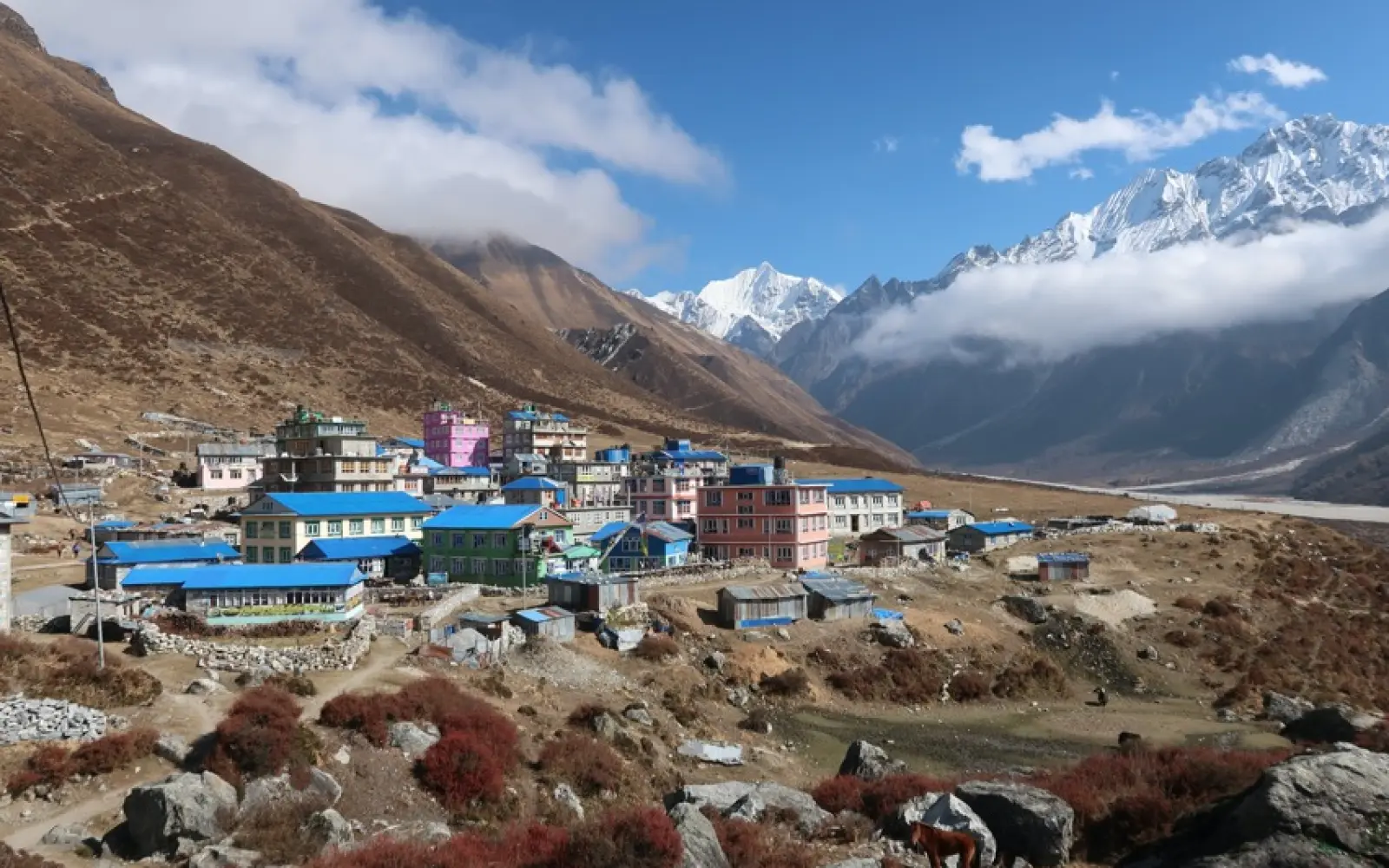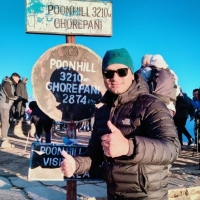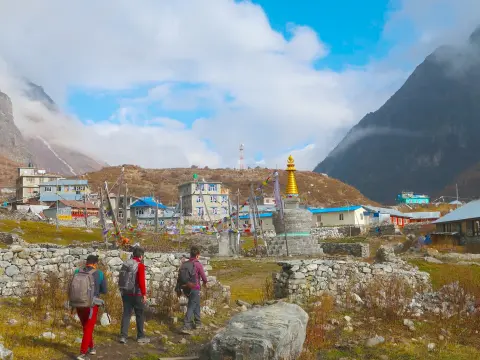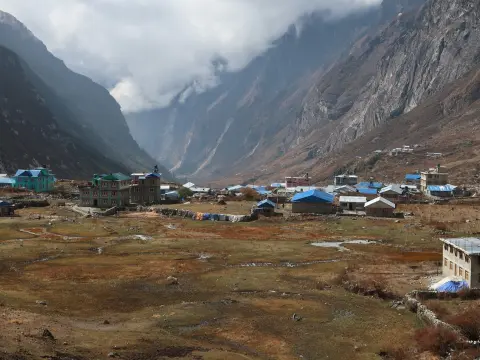Mundu Village: A Peaceful Stop in Langtang Valley
IntroductionMundu Village lies in the Langtang region of Nepal. It is a remote and picturesque Himalayan valley. The village is culturally rich and of...


The final village on the Langtang Valley trek is Kyanjin Gompa. Officially, it sits at 3,870 meters. It is situated at the base of great snow peaks. Langtang Lirung (7,227 m) rises north directly. The village stands by the name of the old monastery within it. "Gompa" is the Tibetan term for a sacred building. It's a natural and religious refuge for travelers.
Meanwhile, after walking for days along forest, village, and riverbanks, the trekkers end up in this serene highland at Kyanjin Gompa. The sight spreads wide across an open valley. The trekkers are surrounded by glaciers, rocks, and white mountains. The sky is closer, and the air is thinner. Prayer flags fly along stone walls. Villagers and yaks walk slowly in the fields.
Likewise, Kyanjin Gompa serves as an acclimatization base and side trip along Langtang Valley Trek. It typically serves as a turnaround point before returning. But it's not so much an end point—it's a treasure. The village itself is serene and meditative. It's raw Himalayan beauty with added depth of culture.
In fact, the grand monastery is in operation in Kyanjin Gompa. It represents generations of Tibetan Buddhist tradition. A nearby Swiss-funded cheese factory adds a unique flavor. Fresh yak cheese can be consumed with mountain tea. Locals live modestly but welcome trekkers with affection. The culture is founded on Tamang and Tibetan traditions.
In brief, Kyanjin Gompa is more than a rest stop. It is a place of spirit, beauty, and peace. It combines nature, culture, and peace in a symphony of harmony. Whether it is for scenery, relaxation, or contemplation, Kyanjin leaves an impression.
Kyanjin Gompa lies in isolated Nepal's Langtang Valley. It is situated at 3,870 meters. It belongs to the Rasuwa District in Bagmati Province. It lies in Langtang National Park, beneath Langtang Lirung (7,227 m), which is among the highest mountains of the region.
Actually, the village Kyanjing Gumba is surrounded by breathtaking Himalayan landscape. Snow peaks, cliffs, and ridges ascend steeply in every direction. The valley is transformed into a glacial plain here, which gives the village an open appearance. Smooth river streams, which are supplied with water from glaciers, run through the landscape. Langtang Khola runs nearby, which provides fresh water and life to the valley.
Meanwhile, to the north of Kyanjin Gompa you have summits like Yala Peak (5,520 m) and Tserko Ri (4,984 m). To the west is Langshisha Ri, and to the south you have rocky hills covered with rhododendron and pine forests. These contrasting features—white ridges and green slopes—create a beautiful view.
Moreover, Kyanjin Gompa is the last permanent village on the Langtang Valley trek. Beyond this, one encounters only yak grazing grounds and seasonal shacks. The nation indicates the gap between woodland lower valleys and alpine country. It is the edge of human habitation.
Due to its altitude, the climate of Kyanjin Gompa changes suddenly. Mornings are usually clear and sunny. Clouds and chilly winds blow in the afternoon. Snowstorms may happen, especially during winter and early spring.
Simply put, Kyanjin Gompa geography makes it beautiful and fascinating. It is located at the heart of the upper Langtang Valley. The open plains and mountain summits around it give a unique mountain flavor. It also places it ideally for vantage points, glacier, and sacred sites. It is a Himalayan gem for trekkers and nature lovers.

One can access Kyanjin Gompa only by trekking. It is situated at 3,870 meters in the Langtang Valley of Nepal. The trek to Kyanjin Gompa usually starts at Syabrubesi village. Syabrubesi is connected by road to Kathmandu, 120 kilometers away. The drive takes about 7 to 9 hours depending upon traffic and weather conditions.
From Syabrubesi, the trekkers trek on a well-established trail north. The route follows along Langtang River and through several villages. They are Lama Hotel, Ghodatabela, Langtang Village, and Mundu. There are accommodations and resting opportunities in each of these villages.
Actually, the trek to Kyanjin Gompa spans about 35 kilometers from Syabrubesi to Kyanjin Gompa. It takes about 6 to 7 days on average to complete the trek. Trekkers acclimatize gradually to avoid sickness. The terrain varies from forest trails to alpine grasslands and rock trails.
In fact, there are no roads or motor access beyond Syabrubesi. However, recently, there is a gravel road up to Langtang Hydropower station. So, people can directly drive in and our from Langtang Hydropower station, half hour drive from Syabrubesi, from Kathmandu. Therefore, all provisions and fuel thus need to be brought in by yaks or porters. This contributes to the trek's immersion and remoteness. Weather and landslides sometimes block the trail temporarily.
Meanwhile, guided treks to Kyanjin Gompa or porter hiring is the preferred option for most trekkers. This helps with routing, heavy load bearing, and community benefitting. The path is typically secure but slippery when wet or snowy.
Summing up, there are helicopter transports, but expensive and used primarily for emergencies at Kyanjin Gompa. The nearest airport to Kyanjin gompa is Tribhuvan International Airport at Kathmandu. In summary, Kyanjin Gompa can be accessed by a standard trekking route from Syabrubesi. The journey is challenging but rewarding. The path offers natural scenery and culture exposure. Trekkers prefer the footpath as an unforgettable mountain trek.
Kyanjin Gompa offers an array of amenities to trekkers in a remote mountain region. Despite being primitive, the amenities are soothing and reassuring during the high-altitude stay. The village is equipped with a couple of tea houses and local-operated lodges. The lodges are cozy with twin beds and thick blankets.
All but the simplest accommodations in Kyanjin Gompa share shower and toilet facilities, some with attached toilets. Hot showers are offered by most of the lodges, typically powered by solar panels or gas heaters. The showers are especially appreciated following arduous hiking days. Electricity is mainly sourced from solar, so power is normally limited on cloudy days.
Basically, the dining areas in Kyanjin Gompa are cozy and accommodate a variety of meals. Nepali foods like dal bhat and momos are popular. Western foods like sandwiches and pasta are also served in most of the lodges to please different palates. Hot drinks in the guise of tea, coffee, and soup keep the visitors warm against the biting cold.
Likewise, there is also a tiny health post in the Kyanjin village for common ailments. It provides simple first aid and advice but is not equipped to handle emergencies. For emergencies, helicopter evacuation to Kathmandu is needed. There is also a nearby cheese factory that produces fresh yak cheese, which the tourists generally partake of.
Moreover, Wi-Fi exists in certain lodges in Kyanjin Gompa, but the internet is slow and sometimes inconsistent. It is possible to charge electronic devices, normally for a fee. The lodges are able to arrange guides, porters, and trekking permits. Trekking equipment, snacks, and basic supplies are found in the shops.
In brief, Kyanjin Gompa offers the major facilities with a warm and homely atmosphere. These are suitable for trekkers and they stay comfortably here. The food, comfort, and services altogether make it a good starting point to visit the upper Langtang Valley.

Kyanjin Gompa is famous for its stunning Himalayan scenery and cultural sites. The village itself is surrounded by high peaks, the highest being Langtang Lirung (7,227 meters). This giant of a mountain dominates the horizon and presents breathtaking views from all sides.
Meanwhile, one of the biggest draws of Kyanjin gompa is Kyanjin Gompa monastery, a significant Tibetan Buddhist monastery. The monastery has existed for centuries and continues to be functioning. It is tastefully adorned with colorful prayer flags and very old statues. One can learn about Buddhist culture and even witness local rituals.
Likewise, another attraction of Kyanjin Gompa is the Langtang Cheese Factory. This tiny factory, operated by a family, produces fresh yak cheese and other milk products. Trekkers are attracted to see the cheese-making process and sample fresh cheese and butter tea. The factory benefits not only the local economy but also culture.
Moreover, nature lovers adore the vast alpine meadows surrounding Kyanjin Gompa. These meadows are dotted with grazing yaks and spring flowers. The peaceful surroundings provide an ideal place to unwind and soak in mountain beauty.
Similarly, natural scenery around Kyanjin gompa is supported by glaciers and moraines around. The trekkers typically walk to the trails to Langtang Glacier and nearby peaks like Tserko Ri (4,984 m) and Kyanjin Ri (4,773 m). The treks provide sweeping views of the Langtang range and Tibetan plateaus beyond.
Penultimately, the village Kyanjin Gompa is also a trekker and nature enthusiast base. Sunrise in the early morning and sunset are perfect moments for photography. Bird watchers can spot Himalayan monals and snow pigeons in the region.
Overall, Kyanjin Gompa's major attractions are its monastery, cheese factory, mountains, and nature. All these together create an enjoyable and culturally educational place to visit in Langtang Valley.
Kyanjin Gompa offers many exciting activities to the trekkers and visitors. The village is a perfect focal point to explore the Langtang region. Visitors enjoy a mix of adventure, culture, and nature.
Meanwhile, one of the most popular activities here in Kyanjin Gompa is a trek to nearby summits. One such favorite is Tserko Ri, 4,984 meters. The hike is about 3 to 4 hours from Kyanjin. From the summit, trekkers enjoy panoramic views of Langtang Lirung (7,227 m) and other peaks. Another favorite is to Kyanjin Ri, 4,773 meters. Both treks acclimatize and offer breathtaking vistas.
Likewise, trekking to Langtang Glacier is also popular here in Kyanjin Gompa. The glacier is located just to the north of the village. One can trek to the rim of the glacier and witness massive ice structures. This gives one an up-close view of Langtang's dramatic landscape.
Moreover, cultural activities here in Kyanjin Gompa involve a visit to the Kyanjin Gompa monastery. One gets to learn about Tibetan Buddhism and local customs. The monastery also has prayer ceremonies and festivals that visitors can participate in. Interaction with the local Tamang people provides a rich cultural experience.
Similarly, relaxation at tea houses is another activity to do in Kyanjin gompa. Trekkers get to enjoy warm food and hot beverages after a day of walking. The tea houses provide comfortable settings to socialize with fellow travelers. Exchange of stories and experiences fosters camaraderie.
Furthermore, photography is a favorite pastime here in Kyanjin Gompa. The combination of mountain, monastery, and wildlife offers unlimited photography opportunities. Early morning and late evening light makes the photographs most beautiful.
Overall, Kyanjin Gompa offers trekking, cultural tours, glacial walks, rest, and photography. They offer a memorable and rewarding stay in Langtang Valley.
Kyanjin Gompa is popular for so many great reasons. To start, it is the highest permanent village along the Langtang trek. It is at an elevation of 3,870 meters. This would be an excellent spot for acclimatization prior to greater ascents. It is highly utilized by trekkers as a place to rest.
Secondly, the breathtaking views of mountains lure tourists here in Kyanjin Gompa. Langtang Lirung, the prominent peak at 7,227 meters, looms large on the horizon. The thin air provides clear visibility. Sunrises and sunsets are pure magic. Photographers are delighted to capture these scenes.
Thirdly, the Kyanjin Gompa village is culturally rich. The old monastery of Kyanjin Gompa is an important religious site. It was a great source of information about Tibetan Buddhism. Local Tamang inhabitants maintain traditional ways of living here. Travelers enjoy immersing themselves in their tradition and festival.
Fourth, the Kyanjin Gompa village is well-located so that it becomes a hub for nearby treks. Trekkers are able to trek Tserko Ri and Kyanjin Ri to witness panoramic views. They are able to trek to the Langtang Glacier. These day treks add adventure and diversity to the stay.
Fifth, the friendly atmosphere of Kyanjin Gompa makes it welcoming. Locally owned lodges offer hospitality and sumptuous food in warmth. The cozy tea houses provide relaxation after exhausting days. This is to rejuvenate the trekkers for the journey ahead.
Lastly, Kyanjin Gompa's combination of nature, culture, and comfort makes it special. It provides adventure with relaxation in harmony. The village is peaceful but busy during trekking seasons. It receives many visitors every year.
In conclusion, Kyanjin Gompa is so popular because it has magnificent views, cultural destination, strategic location, and welcoming hospitality. It remains an indispensable site on the Langtang trek.

Kyanjin Gompa has various accommodation facilities for trekkers. There are several tea houses and lodges in the village. These establishments offer warm rooms and food in the high-altitude environment. The majority of lodges have basic but clean rooms with twin beds. Thick blankets and foam mattresses ensure the comfort of guests on cold nights.
Moreover, most of the bathrooms in Kyanjin Gompa are shared, but there are a few lodges with en-suite toilets. Most have hot showers, typically drawn from solar or gas geysers. Showering after long days of walking is a luxury. Power is supplied by solar panels, and therefore it is low on cloudy days.
Likewise, the dining areas in Kyanjin Gompa are cozy and inviting. Nepali cuisine such as dal bhat, momos, and noodles are served in the tea houses. Western cuisine such as pasta and sandwiches are also served. Hot drinks such as tea, coffee, and soup make the trekkers warm.
Similarly, Wi-Fi is also accessible in some of the lodges in Kyanjin Gompa but are slow or unreliable. Charging electronic gadgets costs a little amount of money. The lodges also arrange trekking permits, guides, and porters. Treks and snacks are sold at small tea houses.
Furthermore, hospitality of local poeple in Kyanjin Gompa is warm and friendly. Local families manage most of the tea houses. They receive visitors with hospitality and excellent service. The lodges also offer a homey atmosphere, and visitors feel comfortable.
In short, the accommodation in Kyanjin Gompa and tea houses provide basic comforts. They are warm, have food, and provide friendly services. This renders the village a nice place to rest and get ready for further trekking. Although located far away, the facilities serve trekkers' basic requirements very well.


IntroductionMundu Village lies in the Langtang region of Nepal. It is a remote and picturesque Himalayan valley. The village is culturally rich and of...

IntroductionDhunche is the headquarter of Rasuwa District in Nepal. It lies at an elevation of 2,030 meters. It is a hill town and a significant gatew...

IntroductionLangtang Village is a picturesque village in the middle of Langtang Valley, Nepal. The village stands at an elevation of 3,430 meters abov...
